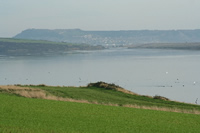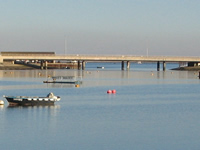Chesil Beach and the Fleet Lagoon
18 miles and 180 billion pebbles


The Fleet lagoon was formed when Chesil Beach moved onshore as the sea levels rose. In the past it was much larger than it is today. The Fleet is 13.1 km (8.2 miles) long and covers an area of 480 hectares. The width varies from 900 metres at Littlesea down to just 65 metres at The Narrows. The deepest part is in the lower Fleet where it is 4-5 metres deep. Most of the upper Fleet above The Narrows is no more than 2 metres deep
The bed of The Fleet has been owned by the Ilchester Estates since 1539
The Fleet connects to the sea via a narrow channel at Ferrybridge into Portland Harbour. Sea water can also enter the Fleet by percolation through Chesil Beach under some tidal conditions. Fresh water can enter the Fleet from a number of small streams and by run-off from the surrounding fields. Under storm conditions water from Lyme Bay can come through and over Chesil Beach in sufficient quantities to make the pebbles highly mobile and voids form in the Fleet side of the beach called canns. Cann events happen during south-westerly gales most winters but are usual minor events in which existing canns become re-established. Major cann events are less frequent, happening roughly every 10-15 years. The last major cann event was in 2014.
At Ferrybridge the water is fully marine with a salinity around 35 parts per thousand (ppt). In the upper Fleet at Abbotsbury the salinity can fall below 16 ppt.
The Fleet is strongly tidal at Ferrybridge but the effect of the tides diminishes above The Narrows. At Abbotsbury the effect of the daily tidal cycle is very small and a much greater effect is due to the monthly cycle of spring and neap tides and storm surges in the Channel.
The water in the Fleet is generally warmer than the surrounding sea in the summer and cooler in the winter. The temperature in the lower Fleet can vary by up to 4ºC during a twelve hour tidal cycle.
The Fleet is an important area for wildlife and has received the following designations:
Special Area of Conservation (SAC)
·Special Protection Area (SPA) under the EU Birds Directive
A Ramsar site
Site of Special Scientific Interest (SSSI)
Designated bass nursery area
For a list of rare and endangered plant species that can be found in and around the Fleet click here. Other species lists available are:
Crustacea
Fish
For a checklist of the birds of Chesil Beach and the Fleet click here. This list has been prepared by Steve Groves.
|
The Fleet derives its name from the Saxon 'fleot', meaning shallow water
|
|
Over 150 species of algae (seaweed), 25 species of fish and 60 species of molluscs have been found in the Fleet
|
|
Up to 5000 brent geese over-winter on the Fleet
|



The Fleet at Littlesea with Portland in the background
The Fleet connects to Portland Harbour under Ferrybridge




